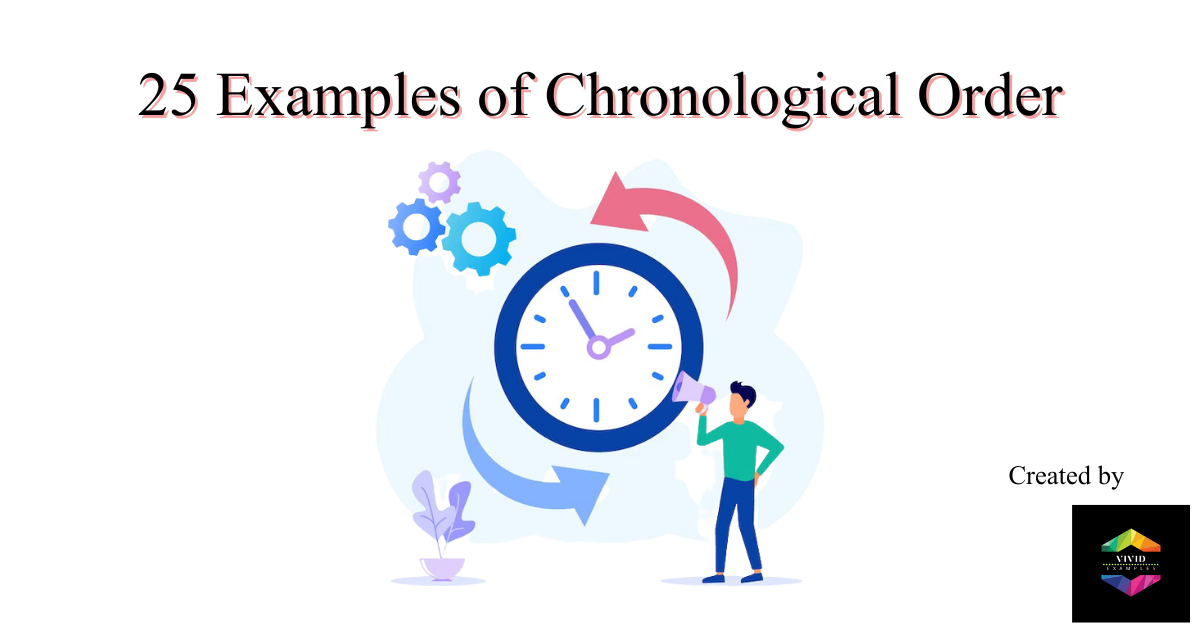Discover the significance of chronological order through 25 diverse examples spanning historical events like the signing of the Declaration of Independence and breakthroughs like the Theory of Relativity. Delve into biographies of visionaries such as Leonardo da Vinci and Marie Curie, while exploring evolutionary processes like human evolution and DNA structure. Chronological order is a fundamental method of organization that arranges events, ideas, or information according to their occurrence in time. This approach helps readers and audiences understand the progression of events and developments in a clear and logical manner. In this article, we will explore 25 diverse examples of chronological order, showcasing its importance across various fields and contexts.
Examples of Chronological Order
Examples of Chronological order are given below,
1. Evolution of Communication: From Smoke Signals to Smartphones
Explore the progression of communication methods over time, from ancient smoke signals and carrier pigeons to the modern-day marvel of smartphones and instant messaging.
2. The Industrial Revolution: A Timeline of Key Inventions
Take a journey through the Industrial Revolution, highlighting key inventions such as the steam engine, cotton gin, and assembly line, showcasing their impact on society.
3. The Life of Leonardo da Vinci: A Chronological Biography
Discover the remarkable life of Leonardo da Vinci, from his early years as an apprentice to his masterpieces and scientific discoveries.
4. America’s Road to Independence: Important Dates and Events
Trace the chronological events leading to America’s Declaration of Independence, including the Boston Tea Party, the signing of the Declaration of Independence, and the Revolutionary War battles.
5. Evolution of Film: Milestones in Cinematic History
Delve into the evolution of film, highlighting key milestones like the Lumière brothers’ first motion picture and the advent of color and sound in movies.
6. Advances in Medicine: A Timeline of Medical Breakthroughs
Examine the chronological timeline of medical achievements, from the discovery of penicillin to modern gene editing techniques like CRISPR.
7. The Art of Writing: Evolution of the Alphabet and Writing Systems
Explore the development of writing systems, from ancient hieroglyphics and cuneiform to the modern alphabet we use today.
8. Human Space Exploration: A Journey Through the Years
Take a chronological tour of human space exploration, including the launch of Sputnik, the Apollo moon missions, and the International Space Station.
9. The Internet Age: Major Technological Landmarks
Chart the rise of the internet, highlighting key moments such as the invention of the World Wide Web, the launch of social media platforms, and the proliferation of e-commerce.
10. Fashion Through the Decades: A Stylish Chronology
Examine how fashion trends have evolved over the decades, from the roaring ’20s to the grunge-filled ’90s and beyond.
11. Ancient Civilizations: Timelines of Mesopotamia, Egypt, and Greece
Compare and contrast the chronological histories of ancient civilizations like Mesopotamia, Egypt, and Greece, showcasing their contributions to human development.
12. Musical Evolution: A Journey in Melody
Trace the chronological evolution of music genres, from classical compositions to the birth of rock ‘n’ roll, hip-hop, and electronic dance music.
13. The Story of Photography: Capturing Moments Through Time
Explore the history of photography, highlighting the invention of the camera, the first photograph, and the transition from film to digital.
14. Technological Marvels of the 21st Century: A Timeline
Discover the breakthroughs that have shaped the 21st century, including the rise of smartphones, artificial intelligence, and renewable energy technologies.

15. The Women’s Suffrage Movement: Progression Toward Equality
Chronicle the milestones of the women’s suffrage movement, from the Seneca Falls Convention to the eventual granting of women’s voting rights.
16. World War I: Key Events and Their Sequence
Examine the sequence of events that led to World War I, from the assassination of Archduke Franz Ferdinand to the signing of the Treaty of Versailles.
17. Natural Evolution: From Single Cells to Complex Organisms
Trace the chronological development of life on Earth, from single-celled organisms to the diverse and complex species that exist today.
18. Rise and Fall of Ancient Empires: A Historical Timeline
Explore the chronological rise and fall of great empires like the Roman Empire, Byzantine Empire, and Ottoman Empire.
19. Human Rights Movement: Progression Towards Global Justice
Chronicle the advancement of the human rights movement, highlighting key events like the Universal Declaration of Human Rights and the establishment of international courts.
20. Technological Innovations in Education: A Chronological Overview
Chart the progression of educational technology, from the advent of chalkboards and textbooks to modern online learning platforms and virtual classrooms.
21. The Age of Exploration: Mapping the World’s Discoveries
Journey through the chronological exploration of the world, from the voyages of Christopher Columbus to the circumnavigation of the globe.
22. Evolution of Video Games: From Pong to Virtual Reality
Explore the chronological evolution of video games, from the simplistic Pong to the immersive experiences of virtual reality gaming.
23. History of Human Art: Prehistoric Times to Modern Creations
Trace the chronological development of art forms, from ancient cave paintings and sculptures to contemporary masterpieces.
24. The Environmental Movement: A Timeline of Conservation Efforts
Chronicle the history of environmental awareness and activism, from the establishment of the first national parks to the global efforts towards sustainability.
25. The Modern LGBTQ+ Rights Movement: A Journey to Equality
Explore the chronological milestones of the LGBTQ+ rights movement, from the Stonewall riots to the legalization of same-sex marriage and ongoing advocacy.
In conclusion, chronological order serves as a powerful tool for understanding the progression of events, ideas, and innovations throughout history. Whether exploring the evolution of communication or the technological marvels of the 21st century, these examples highlight the importance of sequencing information in a clear and organized manner. By employing chronological order, we can unravel the intricate tapestry of our past and make sense of the world’s continuous transformation.

